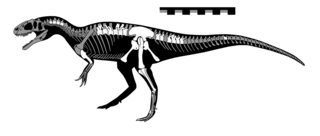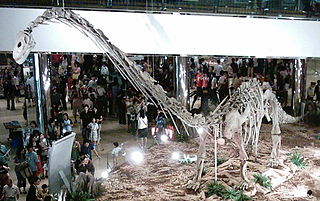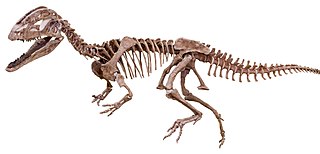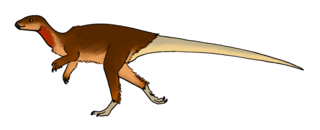
Tetanurae is a clade that includes most theropod dinosaurs, including megalosauroids, allosauroids, tyrannosauroids, ornithomimosaurs, compsognathids and maniraptorans. Tetanurans are defined as all theropods more closely related to modern birds than to Ceratosaurus and contain the majority of predatory dinosaur diversity. Tetanurae likely diverged from its sister group, Ceratosauria, during the late Triassic. Tetanurae first appeared in the fossil record by the Early Jurassic about 190 mya and by the Middle Jurassic had become globally distributed.

Gasosaurus is a genus of tetanuran theropod that lived approximately 171.6 to 161.2 million years ago during the middle of the Jurassic Period. The name "Gasosaurus" is derived from the English "gasoline" and the Greek σαῦρος. Only one species is currently recognised, G. constructus, from which the specific name honours the gasoline company that found the Dashanpu fossil quarry in Sichuan Province, China, now named as the Lower Shaximiao Formation.

Megalosauridae is a monophyletic family of carnivorous theropod dinosaurs within the group Megalosauroidea. Appearing in the Middle Jurassic, megalosaurids were among the first major radiation of large theropod dinosaurs. They were a relatively primitive group of basal tetanurans containing two main subfamilies, Megalosaurinae and Afrovenatorinae, along with the basal genus Eustreptospondylus, an unresolved taxon which differs from both subfamilies.

Piatnitzkysaurus is a genus of megalosauroid theropod dinosaur that lived approximately 179 to 177 million years ago during the lower part of the Jurassic Period in what is now Argentina. Piatnitzkysaurus was a moderately large, lightly built, bipedal, ground-dwelling carnivore that could grow up to 6.6 m (21.7 ft) long.

Megalosauroidea is a superfamily of tetanuran theropod dinosaurs that lived from the Middle Jurassic to the Late Cretaceous period. The group is defined as Megalosaurus bucklandii and all taxa sharing a more recent common ancestor with it than with Allosaurus fragilis or Passer domesticus. Members of the group include Spinosaurus, Megalosaurus, and Torvosaurus. They are possibly paraphyletic in nature with respect to Allosauroidea.

Xuanhanosaurus is a genus of theropod dinosaur that lived during the Middle Jurassic (Bathonian) of the Sichuan Basin, China, around 166 million years ago. This taxon represents one of the various non-coelurosaurian tetanuran taxa found on the Middle Jurassic of the region, uncovered in the Lower Shaximiao Formation. Although it has been known for more than 40 years, this taxon has been the subject of very few studies, although most seem to agree that it is a tetanuran, possibly a basal allosauroid, highlighting the fact that it has a vestigial fourth metacarpal.

Omeisaurus is a genus of sauropod dinosaur from the Middle Jurassic Period of what is now China. Its name comes from Mount Emei, where it was discovered in the lower Shaximiao Formation of Sichuan Province.

Sinosaurus is an extinct genus of theropod dinosaur which lived during the Early Jurassic Period. It was a bipedal carnivore approximately 5.5 metres (18 ft) in length and 300 kilograms (660 lb) in body mass. Fossils of the animal were found at the Lufeng Formation, in the Yunnan Province of China.
Bashunosaurus is a genus of potentially macronarian sauropod dinosaur from the Middle Jurassic Shaximiao Formation of Kaijiang, China. The type and only species is Bashunosaurus kaijiangensis.

Condorraptor is an extinct genus of megalosauroid theropod dinosaur. Its genus name means 'robber from Cerro Condor', referencing a nearby village, while its species name, currumili, is named after Hipolito Currumil, the landowner and discoverer of the locality. It was among the earliest large South American theropods, having been found in Lower Jurassic strata of the Cañadón Asfalto Formation in the Cañadón Asfalto Basin of Argentina. The type species, described in 2005, is Condorraptor currumili. It is based on a tibia, with an associated partial skeleton that may belong to the same individual. Initially described as a basal tetanuran, Benson (2010) found it to be a piatnitzkysaurid megalosauroid and the sister taxon of Piatnitzkysaurus, a finding supported by later studies.

Poekilopleuron is a genus of tetanuran dinosaur, which lived during the middle Bathonian of the Jurassic, about 168 to 166 million years ago. The genus has been used under many different spelling variants, although only one, Poekilopleuron, is valid. The type species is P. bucklandii, named after William Buckland, and many junior synonyms of it have also been erected. Little material is currently known, as the holotype was destroyed in World War II, although many casts of the material still exist.

Avetheropoda, or "bird theropods", is a clade that includes Carnosaurs and coelurosaurs to the exclusion of other Dinosaurs.

The Shaximiao Formation is a Middle to Late Jurassic aged geological formation in Sichuan, China, most notable for the wealth of dinosaurs fossils that have been excavated from its strata. The Shaximiao Formation is exposed in and around the small township of Dashanpu, situated seven kilometres north-east from Sichuan's third largest city, Zigong, in the Da'an District.
Protoxinjiangchelys is an extinct genus of xinjiangchelyid turtle known from the Early to Late Jurassic of China. It is known from the single species P. salis, which was named and described in 2012. It contains only the holotype, ZDM 3009, which consists of a complete shell with an articulated carapace and a complete plastron and possibly another, older specimen.

Piatnitzkysauridae is an extinct family of megalosauroid or basal allosauroid dinosaurs. It only consists of three to four known dinosaur genera: Condorraptor, Marshosaurus, Piatnitzkysaurus and possibly Xuanhanosaurus. The most complete and well known member of this family is Piatnitzkysaurus, which also gives the family its name.

Sciurumimus is an extinct genus of tetanuran theropod from the Late Jurassic Torleite Formation of Germany. It is known from a single juvenile specimen representing the type species, Sciurumimus albersdoerferi, which was found in a limestone quarry close to Painten in Lower Bavaria. The specimen was preserved with traces of feather-like filaments.
The Zhiluo Formation is a geological formation in China, it is also alternatively considered a geological group under the name Zhiluo Group. It dates to the Middle Jurassic. It consists of sandstone, mudstone and siltstone of varying colours. It has received scientific attention for its uranium ore bodies present in the lower part of the formation. Fossil theropod tracks have been reported from the formation. These were described from two footprints found in Jiaoping Coal Mine by C. C. Young in 1966 as Shensipus tungchuanensis. These were in 2015 suggested to belong to Anomoepus. The dinosaur Lingwulong has been suggested to have come from the strata of this formation, previously having been attributed to the underlying Yanan Formation.

Sanxiasaurus is a genus of neornithischian dinosaur from the Middle Jurassic Xintiangou Formation in the Chongqing Municipality of China. The type and only species is S. modaoxiensis. The holotype is a partial postcranial skeleton consisting of "55 bones including two cervical vertebrae, 11 dorsal vertebrae, 4 sacral vertebrae, 18 caudal vertebrae, both humeri, radii and ulnas, partial right ilium, partial right ischium, both femora and tibiae, left fibula, 3 metatarsi and 4 phalanges." In a phylogenetic analysis, it was found to be a basal neornithischian, more derived than Lesothosaurus and less derived than Hexinlusaurus.
The Xintiangou Formation is a geological formation in China. Part of the stratigraphy of the Sichuan Basin, it is of an uncertain Middle Jurassic age, with preliminary U-Pb estimates giving an age range of 170 ma. It predominantly consists of interbedded mudstone and sandstone, with subordinate shelly limestone. At the Laojun site remains of lungfish, bony fish, freshwater sharks, temnospondyls, plesiosaurs, crocodyliformes, the Xinjiangchelyid turtle Protoxinjiangchelys and tritylodontids are known. The dinosaurs Sanxiasaurus,Yunyangosaurus, and indeterminate sauropods are also known from the formation. Theropod and ornithopod tracks have also been reported from the formation.

Bashanosaurus is an extinct genus of stegosaurian dinosaur from the Middle Jurassic Shaximiao Formation of Yunyang County, China. The genus contains a single species, Bashanosaurus primitivus, known from incomplete skeletons belonging to three individuals. It is one of the basalmost stegosaurs, as well as one of the oldest known stegosaurs, along with Adratiklit, Isaberrysaura, and Thyreosaurus.





























